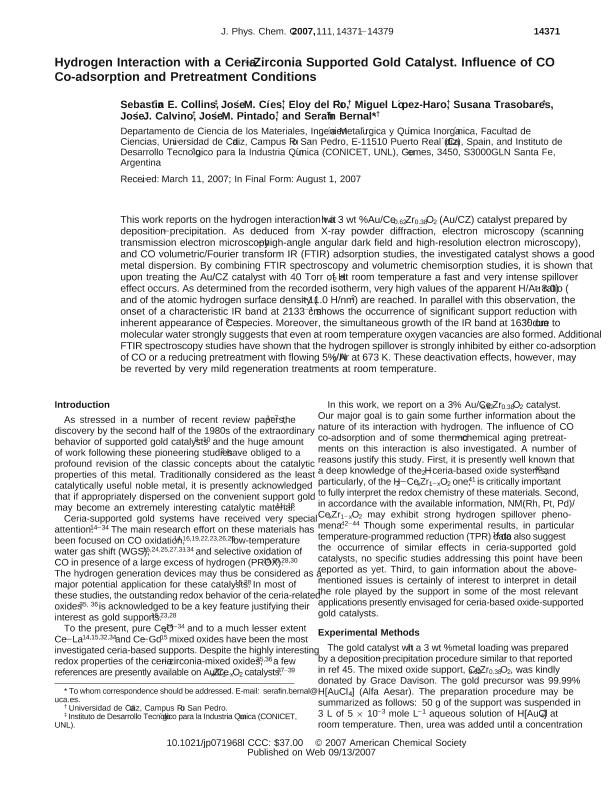Artículo
Hydrogen interaction with a ceria-zirconia supported gold catalyst. Influence of CO co-adsorption and pre-treatment conditions
Collins, Sebastián Enrique ; Cíes, José M.; del Río, Eloy; Lopez Haro, Miguel; Trasobares, Susana; Calvino, José J.; Pintado, José M.; Bernal, Serafín
; Cíes, José M.; del Río, Eloy; Lopez Haro, Miguel; Trasobares, Susana; Calvino, José J.; Pintado, José M.; Bernal, Serafín
 ; Cíes, José M.; del Río, Eloy; Lopez Haro, Miguel; Trasobares, Susana; Calvino, José J.; Pintado, José M.; Bernal, Serafín
; Cíes, José M.; del Río, Eloy; Lopez Haro, Miguel; Trasobares, Susana; Calvino, José J.; Pintado, José M.; Bernal, Serafín
Fecha de publicación:
12/2007
Editorial:
American Chemical Society
Revista:
Journal of Physical Chemistry C
ISSN:
1932-7447
Idioma:
Inglés
Tipo de recurso:
Artículo publicado
Clasificación temática:
Resumen
This work reports on the hydrogen interaction with a 3 wt % Au/Ce0.62Zr0.38O2 (Au/CZ) catalyst prepared by deposition−precipitation. As deduced from X-ray powder diffraction, electron microscopy (scanning transmission electron microscopy−high-angle angular dark field and high-resolution electron microscopy), and CO volumetric/Fourier transform IR (FTIR) adsorption studies, the investigated catalyst shows a good metal dispersion. By combining FTIR spectroscopy and volumetric chemisorption studies, it is shown that upon treating the Au/CZ catalyst with 40 Torr of H2 at room temperature a fast and very intense spillover effect occurs. As determined from the recorded isotherm, very high values of the apparent H/Au ratio (>8.0) and of the atomic hydrogen surface density (>11.0 H/nm2) are reached. In parallel with this observation, the onset of a characteristic IR band at 2133 cm-1 shows the occurrence of significant support reduction with inherent appearance of Ce3+ species. Moreover, the simultaneous growth of the IR band at 1630 cm-1 due to molecular water strongly suggests that even at room temperature oxygen vacancies are also formed. Additional FTIR spectroscopy studies have shown that the hydrogen spillover is strongly inhibited by either co-adsorption of CO or a reducing pretreatment with flowing 5% H2/Ar at 673 K. These deactivation effects, however, may be reverted by very mild regeneration treatments at room temperature.
Archivos asociados
Licencia
Identificadores
Colecciones
Articulos(INTEC)
Articulos de INST.DE DES.TECNOL.PARA LA IND.QUIMICA (I)
Articulos de INST.DE DES.TECNOL.PARA LA IND.QUIMICA (I)
Citación
Collins, Sebastián Enrique; Cíes, José M.; del Río, Eloy; Lopez Haro, Miguel; Trasobares, Susana; et al.; Hydrogen interaction with a ceria-zirconia supported gold catalyst. Influence of CO co-adsorption and pre-treatment conditions; American Chemical Society; Journal of Physical Chemistry C; 111; 39; 12-2007; 14371-14379
Compartir
Altmétricas



